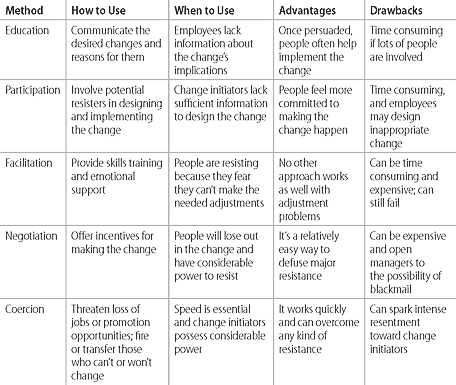Choosing Strategies for Change
The Idea in Brief
Faced with stiffer competition and dizzying technological advances, companies often must change course to stay competitive. But most change initiatives backfire. That's because many managers take a one-size-fits-all approach to change. They assume they can combat resistance, a notorious obstacle, by involving employees in the design of the initiative. But that works only when employees have the information they need to provide useful input. It's disastrous when they don't. Also, managers often don't tailor the speed of their change strategy to the situation. For instance, they may apply a go-slow approach even when an impending crisis calls for rapid change.
To lead change successfully, Kotter and Schlesinger recommend:
Diagnosing the types of resistance you'll encounter--and tailoring your countermeasures accordingly. To illustrate, with employees who fear the adjustments the change will require, provide training in new skills.
Adapting your change strategy to the situation. For example, if your company must transform to avert an imminent crisis, accelerate your initiative--even if that risks greater resistance.
The Idea in Practice
The authors suggest these steps for managing change successfully:
1. Analyze Situational Factors
Ask yourself:
- "How much and what kind of resistance do we anticipate?"
- "What's my position relative to resisters--in terms of my power and the level of trust between us?"
- "Who--me or others--has the most accurate information about what changes are needed?"
- "How urgent is our situation?"
2. Determine the Optimal Speed of Change
Use your analysis of situational factors to decide how quickly or slowly your change should proceed. Move quickly if the organization risks plummeting performance or death if the present situation isn't changed. But proceed slowly if:
- Resistance will be intense and extensive
- You anticipate needing information and commitment from others to help design and implement the change
- You have less organizational power than those who may resist the change
3. Consider Methods for Managing Resistance
- Purchase the full-length Harvard Business Review article here.
- Visit Harvard Business Online.
- See more on Leadership and Managing People at Harvard Business Online.
Copyright 2008 Harvard Business School Publishing Corporation. All rights reserved.
Further Reading
Articles
Leading Change: Why Transformation Efforts Fail
Harvard Business Review
January 2007
by John P. Kotter
Dealing with resistance is crucial to successful change management, but there other things leaders must do in addition. Kotter lays out eight stages you need to manage in order to give your transformation effort the best chance of succeeding: 1) Establish a sense of urgency, 2) Form a powerful guiding coalition to lead the effort, 3) Create a vision to direct the change initiative, 4) Communicate the vision, using every vehicle possible, 5) Empower others to act on the vision; for example, by encouraging risk taking, 6) Create short-term wins (visible performance improvements) to whip up enthusiasm, 7) Consolidate performance improvements and produce more change, and 8) Institutionalize new approaches developed during the initiative.
Harvard Business Review
April 2001
by Michael Beer and Nitin Nohria
To lead change successfully, managers must balance two seemingly incompatible approaches. "Theory E" change emphasizes economic value, as measured only by shareholder value. "Theory O" change stresses developing organizational culture and human capability. You can balance these two approaches along several dimensions, including goals, focus, and reward systems. For example, the CEO of U.K. grocery chain ASDA boosted economic value through painful structural changes, such as removing top layers of hierarchy and freezing wages. He also fostered transparency and egalitarianism throughout the organization, making ASDA "a great place for everyone to work." A culture of trust and openness developed, and shareholder value increased eightfold.
The Hard Side of Change Management
Harvard Business Review
October 2005
by Harold L. Sirkin, Perry Keenan, and Alan Jackson
Leading change isn't just about dealing with "soft" issues such as resistance. You also need to deal with "hard" elements. The authors identify four: 1) Duration: Review complex change projects every 2 weeks; more straightforward initiatives, every 6-8 weeks. 2) Integrity: Assemble a change team comprising people who have problem-solving skills, are results oriented, can tolerate ambiguity, possess organizational savvy, and disdain the limelight. 3) Commitment: Visibly endorse the change effort--no amount of public support is too much. 4) Effort: Ensure that no one's workload increases more than 10% in implementing the change. If necessary, remove nonessential regular work from employees with key roles in the transformation project.
